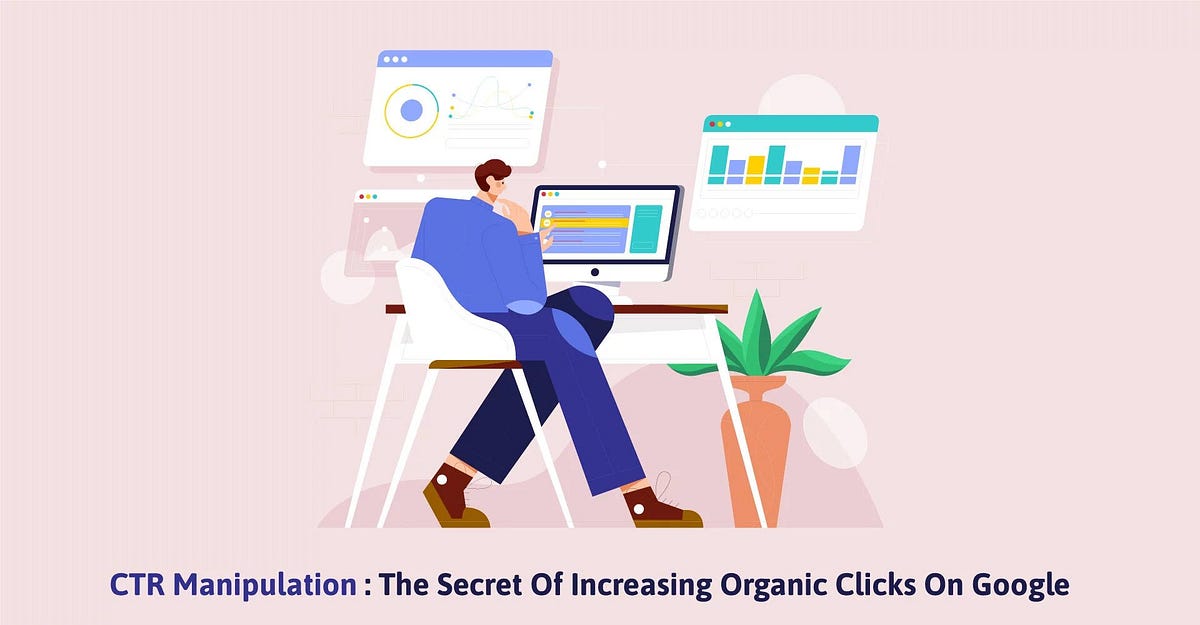Accomplishing Online Success Via Strategic CTR Adjustment
In the electronic landscape, achieving on-line success progressively pivots on the nuanced art of critical click-through price (CTR) manipulation. Exploring the delicate interplay of psychology, analytics, and innovative execution reveals a pathway to not just improve CTR however likewise grow long-term connections with target markets.

Recognizing Click-Through Fees
Understanding the intricacies of click-through rates (CTR) is important for marketing professionals intending to optimize their electronic projects. CTR, specified as the proportion of customers who click a certain web link to the number of total users that check out a web page, ad, or email, serves as a crucial statistics in assessing the effectiveness of on-line advertising and marketing methods. A higher CTR shows that the material reverberates well with the target market, prompting involvement and communication.
To determine CTR, the formula is simple: split the variety of clicks by the variety of impacts and multiply by 100 to share it as a percentage. This dimension not only provides insight right into the efficiency of promotions yet likewise reveals opportunities for improvement. By assessing CTR, marketing experts can determine which aspects of their projects-- such as headings, photos, or call-to-action switches-- are most efficient in driving clicks.
Additionally, understanding market standards for CTR is important, as they can differ substantially throughout different sectors. By continually keeping track of and readjusting methods based upon CTR data, marketing experts can refine their projects, improve customer involvement, and inevitably drive conversions, consequently adding to the total success of their electronic marketing efforts.
The Psychology of Online Behavior
The effectiveness of electronic marketing methods mostly rests on the emotional triggers that affect online habits. Understanding these triggers is necessary for crafting engaging material that resonates with customers and drives interaction. Key emotional principles, such as social evidence, deficiency, and seriousness, play a considerable role fit users' choices.
Social evidence, as an example, leverages the tendency of people to look to others for advice, making reviews and individual testimonials effective tools in convincing possible customers. Shortage methods, which develop an understanding of restricted schedule, can oblige individuals to act swiftly, fearing they might lose out on a possibility. Seriousness infuses a sense of immediacy, prompting users to make quicker choices and minimizing the possibility of laziness.
Additionally, the cognitive predispositions that impact on the internet habits, such as anchoring and loss aversion, can be harnessed to improve advertising and marketing initiatives. By tactically positioning info and highlighting possible losses over gains, marketers can significantly affect customer choices. In a progressively competitive digital landscape, comprehending the complexities of online behavior psychology is essential for attaining sustained success and enhancing click-through rates.
Techniques for Improving CTR
Improving click-through rates (CTR) is necessary for taking full advantage of the efficiency of electronic advertising and marketing projects. Including numbers, concerns, or emotional triggers can considerably improve interaction.
One more reliable technique is leveraging high-quality visuals. Involving photos or videos can draw users in, making them more probable to click on the link. In addition, utilizing A/B screening allows online marketers to explore different content layouts, determining which variations yield the highest CTR.
Tactically positioning calls-to-action (CTAs) within your web content is likewise important. CTAs must be clear, persuasive, and located prominently to assist individuals towards the desired action. Personalizing material based on individual habits and preferences can produce an extra relevant experience, boosting the likelihood of clicks.
Last but not least, making sure that landing pages are optimized for mobile tools is important, as a substantial section of web traffic currently originates from smart devices. A smooth user experience across all gadgets can considerably boost CTR and drive much better results for digital advertising initiatives. By applying these strategies, online marketers can efficiently improve their click-through rates.
Measuring and Assessing Your CTR
Determining and evaluating click-through prices (CTR) is a crucial component of assessing the success of digital marketing projects. CTR, defined as the proportion of users that click on a certain link to the total number of individuals who watch the page, acts as a key efficiency sign. A comprehensive analysis starts with the aggregation of CTR information across various channels, including email, social networks, and paid ads.

Furthermore, tracking fads in time is important. A regular boost in CTR might show efficient techniques, while a decline can signify the requirement for immediate changes. Comparative analysis with market standards additionally contextualizes efficiency, using insights right into essential enhancements.
Eventually, determining and evaluating CTR not just notifies tactical decision-making but also cultivates a culture of continuous improvement in advertising efforts, guaranteeing that campaigns properly get to go right here and resonate with target market. CTR Manipulation.
Moral Factors To Consider in CTR Control
As digital advertising and marketing significantly counts on click-through rates (CTR) to assess efficiency, ethical considerations surrounding CTR control have actually come to the center. While maximizing CTR with critical approaches can enhance presence and interaction, it is essential to examine the effects of such practices.
Manipulating CTR via misleading strategies, such as clickbait headlines or deceptive advertisements, can deteriorate customer trust and damage brand name online reputation. These techniques may yield temporary gains however often cause lasting effects, including customer backlash and regulatory analysis (CTR Manipulation). Ethical marketing stresses openness, encouraging businesses to present precise info that lines up with customer assumptions
Moreover, the rise of man-made knowledge and automated click generation presents additional ethical obstacles. Utilizing crawlers or other automated systems to pump up CTR weakens the honesty of efficiency metrics and skews advertising and marketing data, making complex decision-making processes.
Ultimately, marketers need to stabilize the quest of greater CTR with honest criteria that prioritize honesty and consumer well-being. By moved here cultivating real involvement and supplying worth to customers, brands can attain sustainable success while promoting ethical marketing concepts. In navigating these considerations, companies will not only safeguard their track record yet additionally cultivate a dedicated client base.
Verdict
In recap, achieving on the internet success find out this here via strategic CTR adjustment calls for a multifaceted technique that stabilizes optimization techniques with ethical factors to consider. Ultimately, a dedication to moral criteria in CTR techniques not just boosts performance however also cultivates lasting connections with target markets.